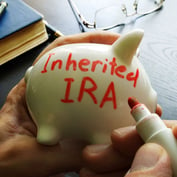Much has been written about the benefits of converting retirement assets in a traditional IRA to a Roth IRA. During 2020, Roth conversions received a lot of favorable press with tax rates being low and the stock market being depressed for part of 2020.
This is a retirement savings strategy that might be beneficial for some of your clients, but like any financial strategy it should be looked at on a case-by-case basis to determine if it is a good fit for a particular client.
Here’s a detailed look at Roth IRA conversions to help you decide if this strategy is a good fit for your clients.
What Is a Roth IRA Conversion?
In a Roth IRA conversion, the account holder takes some or all of the balance in their traditional individual retirement account and converts that money to a Roth IRA. The money converted to a Roth IRA is taxable as ordinary income in the year the conversion is made. The exception is the value of any after-tax contributions made to the traditional IRA that are part of the amount converted.
Another possible type of a Roth IRA conversion might occur if your client is leaving their employer. A traditional 401(k) account can be rolled over and converted to a Roth IRA. The tax rules described above will still apply. Depending upon the rules of both the client’s 401(k) plan and those of the IRA custodian, an interim transfer to a traditional IRA may be required.
Once a Roth IRA conversion is completed, distributions from the account are tax-free as long as certain requirements are met.
Roth IRA Conversions, RMDs and Taxes
When considering a Roth conversion for a client, there are a number of issues to consider.
Notwithstanding the required minimum distribution waiver in effect for 2020, any RMDs for the year must be taken first, and the RMD amount cannot be converted to a Roth IRA. For example, if your client wanted to convert their entire traditional IRA balance to a Roth IRA, they would need to take their full RMD for the year prior to converting the rest of the account to a Roth IRA.
Generally, all assets converted from a traditional IRA account to a Roth IRA will be subject to taxes at ordinary income tax rates. The exception to this are any contributions made on an after-tax basis. Any gains on the investments in the account, regardless of whether the contributions were made on a pretax or after-tax basis, are also subject to taxes in a Roth conversion.
Where the client has traditional IRA money from after-tax contributions, pretax contributions and investment gains, calculating the amount of the conversion that is subject to taxes can become complex. This situation sometimes arises in the case of a backdoor Roth conversion discussed below.
It’s important to be sure that your client has sufficient cash outside of the traditional IRA to cover the taxes on the Roth conversion. If they need to tap their traditional IRA to cover the tax bill, these withdrawals will be subject to taxes and potentially to a 10% penalty if the client is younger than 59 ½. This could make the conversion quite expensive for your client and might lead you to suggest that the client forgo some or all of this conversion.
How Can a Roth IRA Conversion Benefit Clients?
A Roth IRA conversion can have several potential benefits for clients.
Roth IRAs are not subject to RMDs. For clients who don’t need the RMD income in retirement, this can result in tax savings each year. Additionally, this allows the value of the account to remain intact and potentially continue to grow over time. A Roth IRA can be a powerful estate planning vehicle for leaving money to a spouse or other heirs.
A Roth IRA can provide your client with tax diversification in retirement. This can be beneficial as we don’t know what direction tax rates will take in the future. At the time of this writing, we are on the cusp of a new presidential administration. Many speculate that President Joe Biden will look to raise taxes over the next few years. A Roth IRA conversion can act as a hedge against future tax rate hikes. Having retirement savings in both Roth and traditional retirement accounts can provide flexibility for your clients in helping them formulate a retirement withdrawal strategy.
In general, the decision regarding a Roth IRA conversion is often about your client’s current tax situation versus their anticipated future tax situation. With multiple income sources like pensions, withdrawals from retirement accounts and Social Security, it’s not uncommon for your clients to end up in a higher tax bracket in retirement than they were while they were working.
Roth Conversion Disadvantages
As with any financial strategy, a Roth IRA conversion is not the right answer for everyone. Here are some situations where a Roth conversion may not make sense, or at least where a careful analysis is required. Most of these types of decisions involve the merits of paying taxes now in exchange for the benefits of a Roth IRA at some point in the future.
When considering a Roth conversion, it’s important to look at the potential payback — specifically, the amount of taxes that will be due on the conversion upfront compared to the client’s life expectancy. This is especially crucial for a client who is 60 or older. An analysis needs to be run to analyze a potential break-even point where the benefits of doing the conversion, such as tax-free withdrawals and not taking RMDs, outweigh the current taxes due on the conversion.









 January 05, 2021 at 11:10 AM
January 05, 2021 at 11:10 AM











